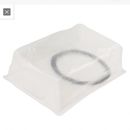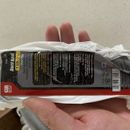Duct Sealing Clay for Conduit Penetrations
Sorry for making so many threads. Just a bunch of details before drywall. I’m installing the clear plastic led light fixture vapor barrier bag thingys on all my light fixtures. As far as sealing the hole I have to cut in the bag for the wiring to come through, has anyone had any luck with the duct sealing clay used for conduit? I know it’s not the fancy 3m fire block red putty stuff but do I really need to worry about that? I’ll include pics of both. Thanks.
GBA Detail Library
A collection of one thousand construction details organized by climate and house part











Replies
The red putty pads are probably more likely to hold up over time compared with the tar-like black "duct seal" product.
Another possible option would be the red "fire stop" caulk, which may actually work even better than the red putty pads here. I don't think the black duct seal stuff is going to work very well here. What I would probably do is put some caulk around the cable, then squeeze the bag around it a little and tape it to hold things together while the caulk cures. That's probably the best way to ensure a good seal if your goal is perfection (or close to that :-).
Bill
Thanks! This stuff was just readily available from my dad’s hardware store so figured I’d try it. Not really an easy way to do this as I’ve learned pulling wires through the certainteed membrane. I kind of did what you mentioned with silicone an tape there with limited success.
I’m trying to make the hole small enough and then pull the wiring through it to kind of ream the plastic out so it’s pretty tight on it’s own. First line of defense is the supposedly air tight led and fixture itself against the drywall. Then these plastic cover things, then I guess blown in cellulose on top. Hopefully it will never get to that point. I need every inch of actual r value performance I can get in those eaves because the joists and rafters sit right on the top plate. Combined with a low sloped roof and the vent baffles I installed sometimes there’s only a few inches of space at the top plate for insulation. I can foamed the baffles in place so no outside air can infiltrate into the insulation at its weakest point so hopefully I’ll get as much as I can out of it. If you can’t tell I’m really worried about ice damming haha. I think I’ll be good though once the put the snow rail on (new aluminum standing seam roof).
christian_330,
If the plastic cover isn't fire rated, does using a fire rated caulk or putty do much? I'd probably use whatever silicone caulking I had lying around.
That was my thinking. The covers say they exceed the rating for 194° F for retrofit applications but it’s not like they’re fire proof. I doubt the led or wiring will get hot enough in there to cause problems and blocking the air is a big priority for me.
That's a good point. No need to use fire stop caulk here, I guess talk of fire putty pads had me in fire stop thinking mode :-) We use a lot of that stuff at work.
For a basic air seal like this, where it's not really subject to any stress, pretty much any caulk that will adhere to the materials you're trying to seal will work fine. The biggest concern I would have is that the relatively stiff wire will want to move around and open up the hole befoer the caulk can cure, which is why I recommended using some tape around it too. It can be tricky to get a reliable air seal where power cables pass through a membrane. I have in the past tried to route the cables through small "plates" made of scrap rigid foam so that I can tape the membrane to the foam, and then seal the wires to the rigid foam using canned foam. This is more reliable compared to going through the membrane directly. I've always built foam boxes to cover can lights when needed, so I've never tried sealing a membrane-style air barrier on those before.
Bill
The only thing I've used on vapor barrier hats is Tuck tape (Canadian acrylic technical tape, similar to most sheathing tapes). Run the wire through one of the corners (easiest spot to seal) and tape around to seal it up.